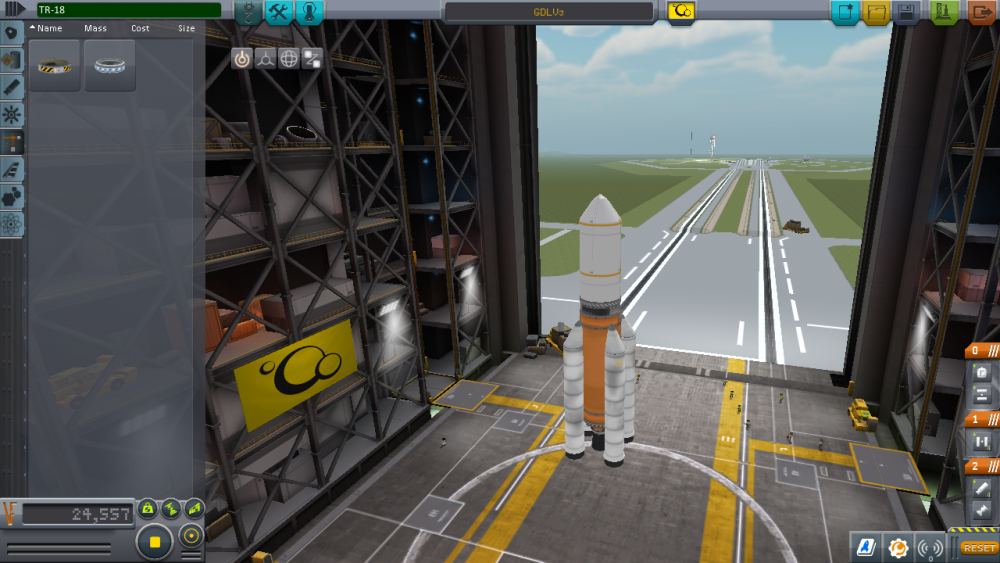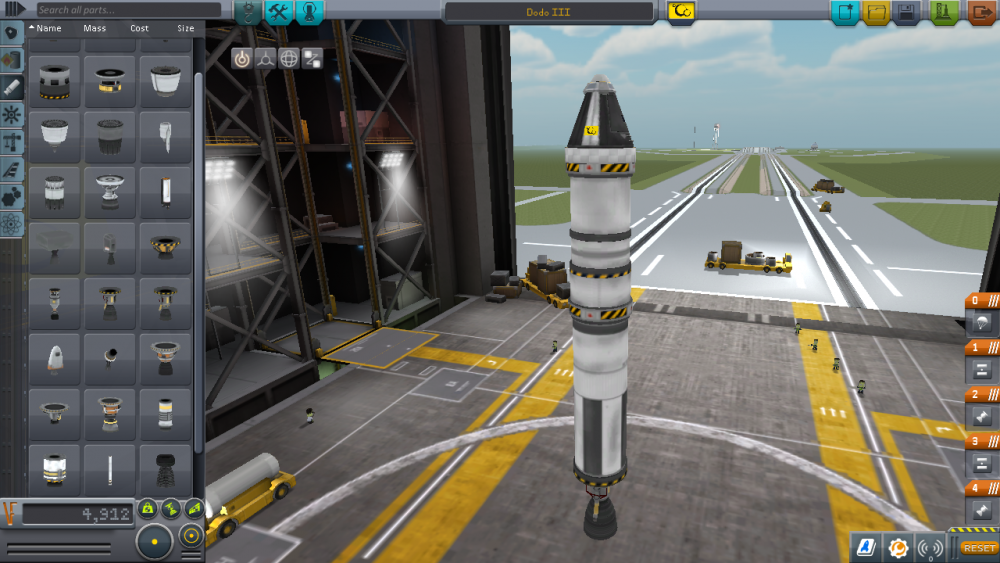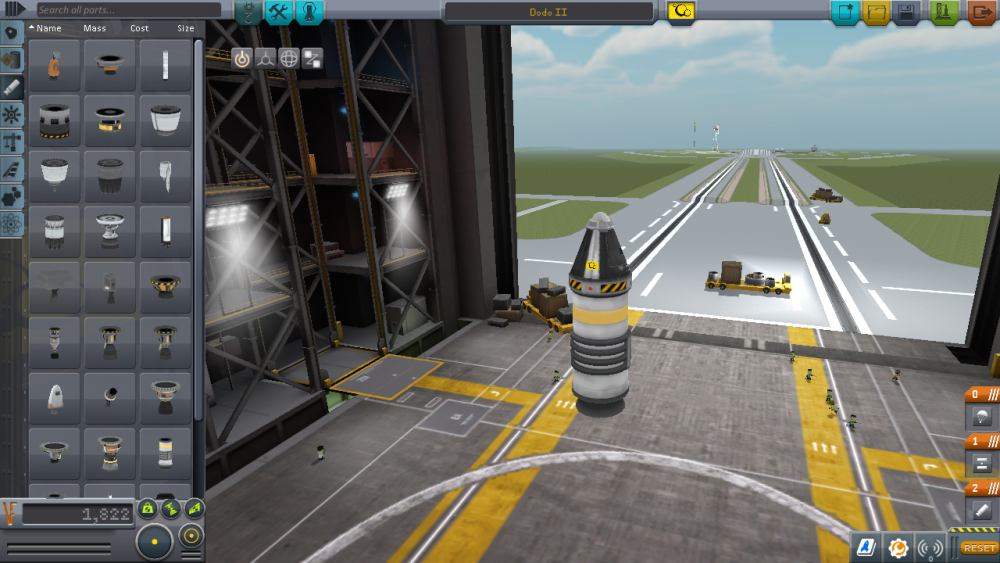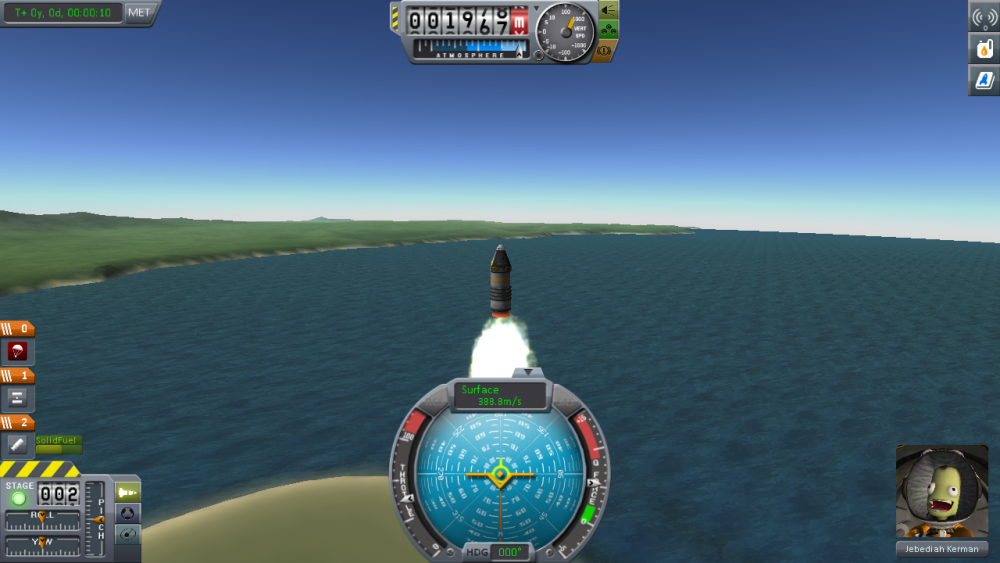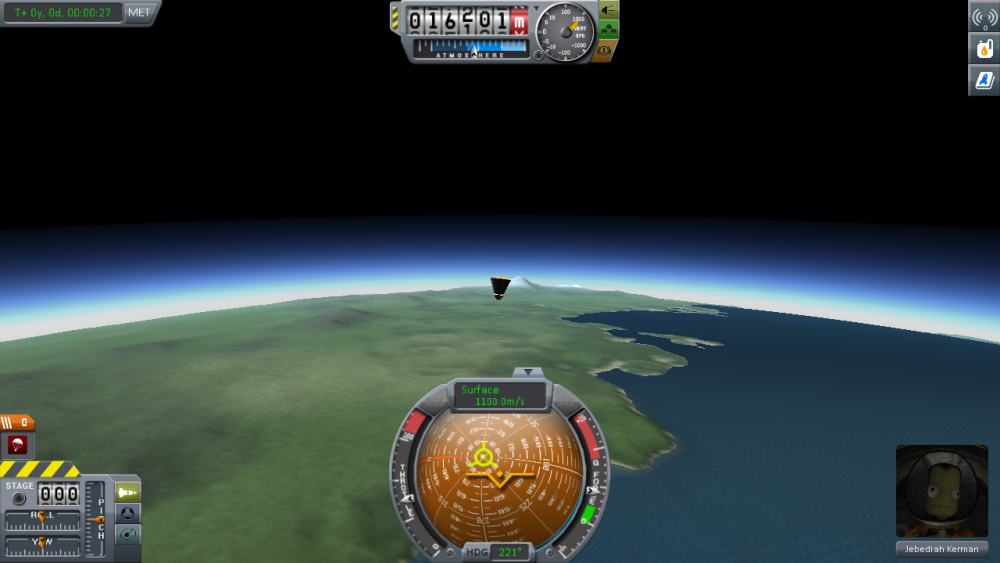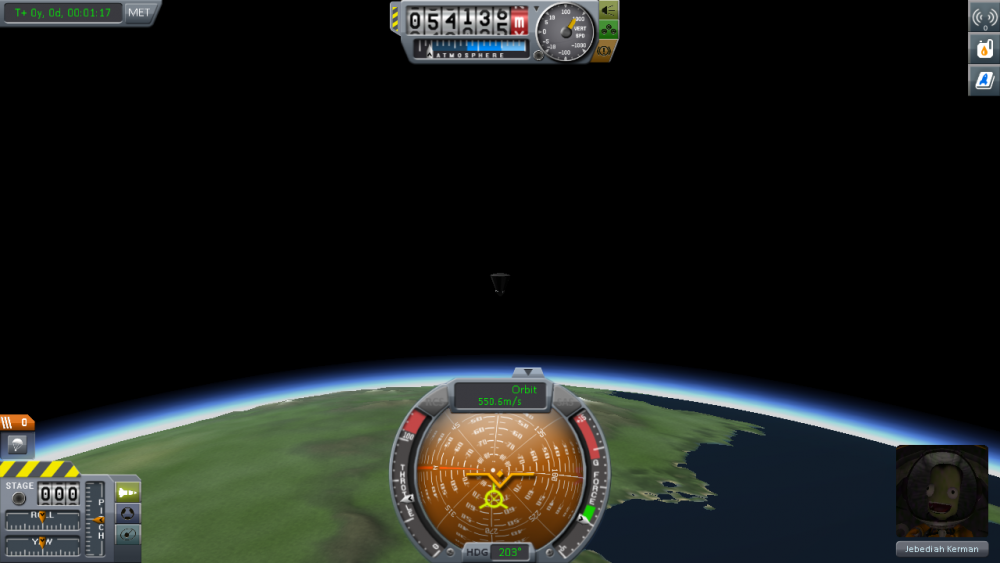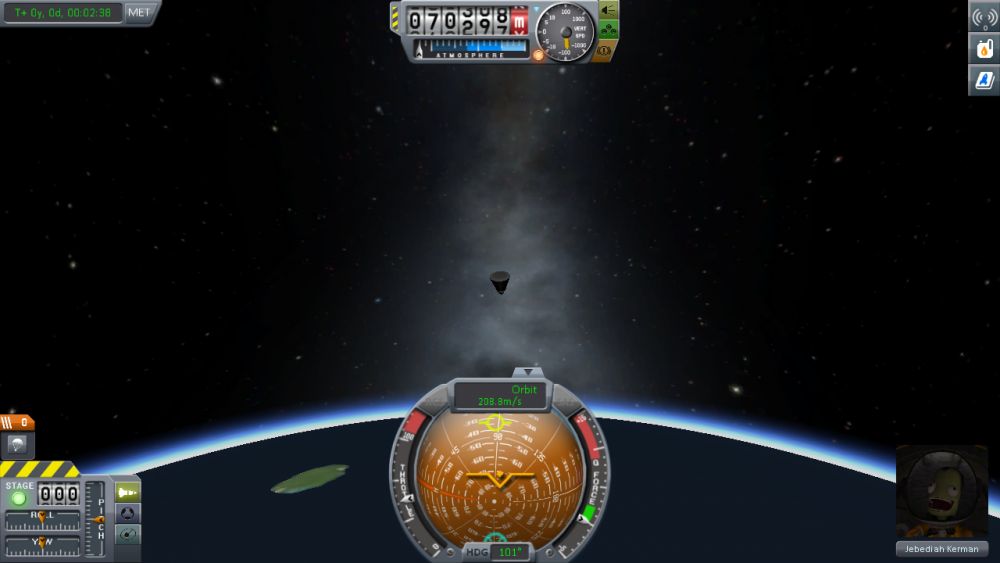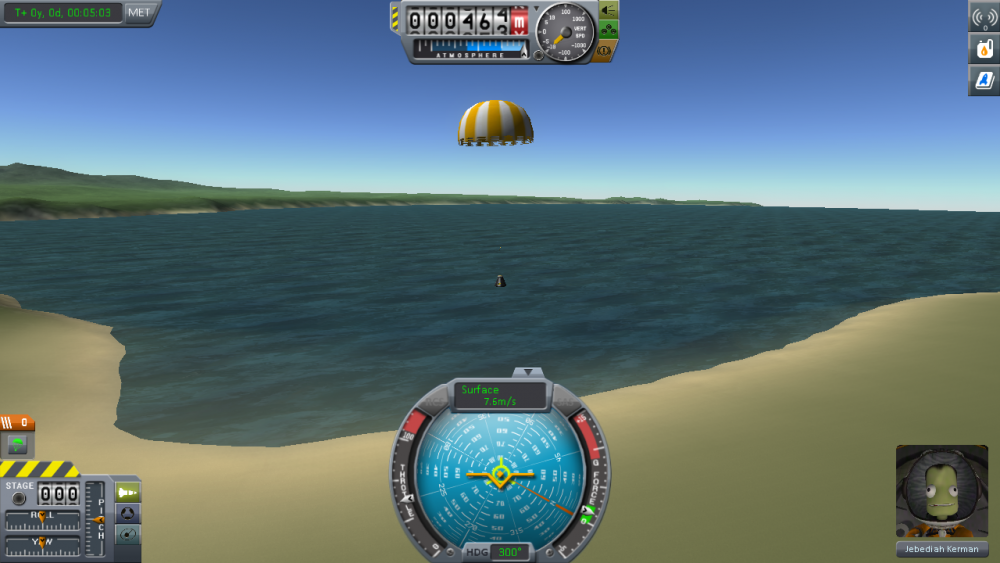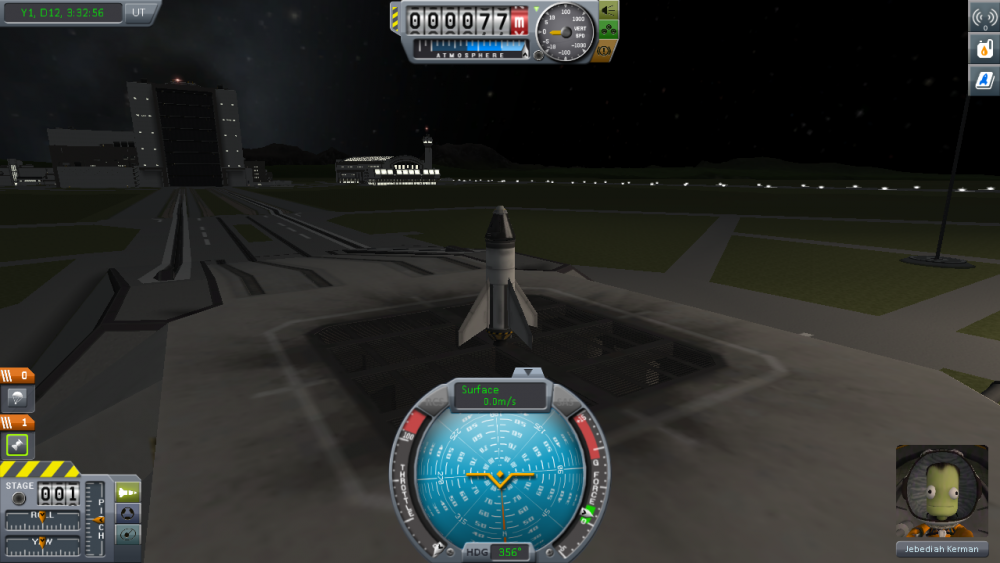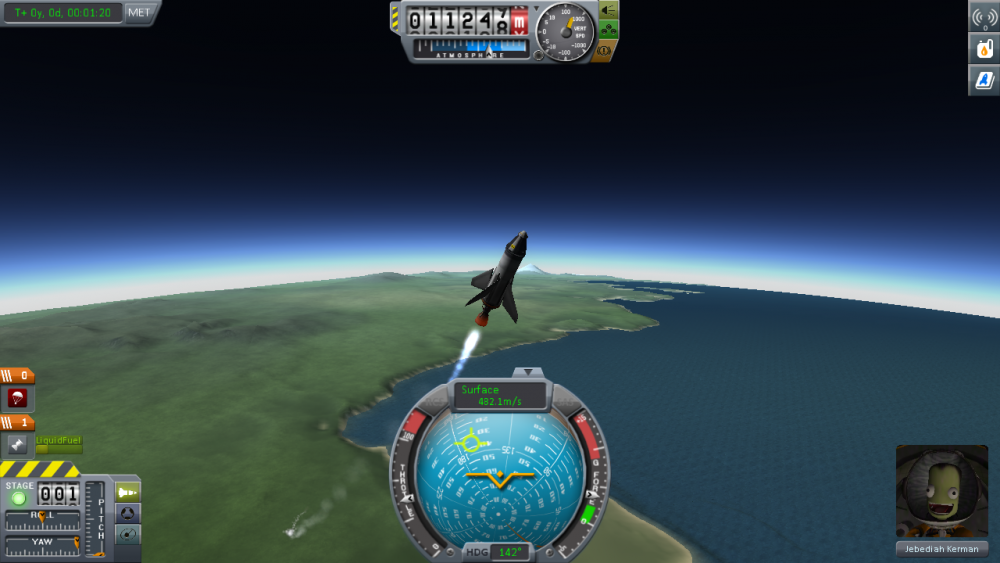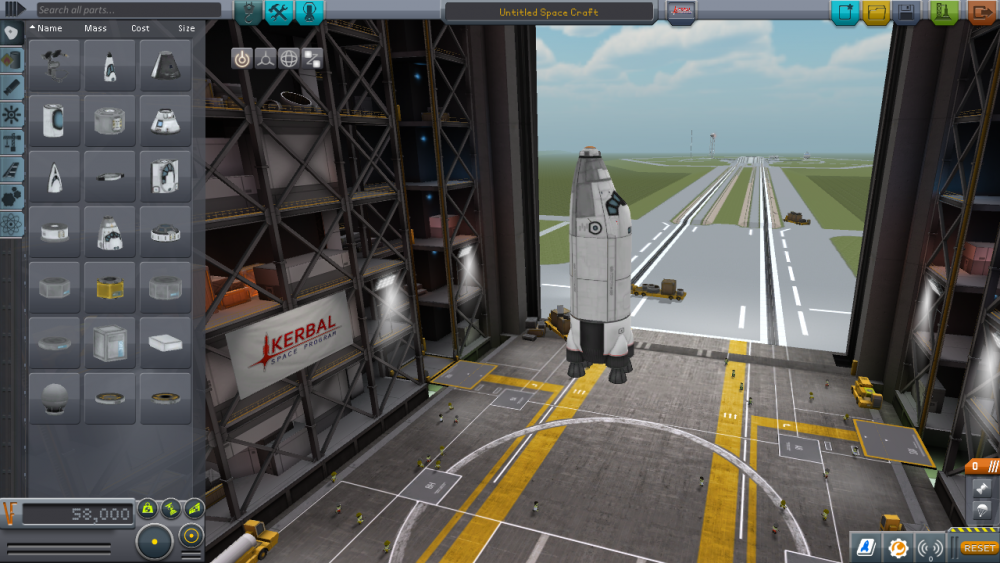
ajgartland22
Members-
Posts
63 -
Joined
-
Last visited
Recent Profile Visitors
The recent visitors block is disabled and is not being shown to other users.
ajgartland22's Achievements
Newbie (1/14)
0
Reputation
-
Kerbal Flight #4 Pre- Flight Briefing Team Name: Jamison Industries LLP Available Funds: $167,464 Vehicle Name: Bird Food Vehicle Parts List and Cost: BACC Solid Booster $3,400 Rockomax Jumbo-64 Fuel Tank $5,750 RE-15 Liquid Fuel Engine $5,300 AE-FF2 Airstream Protective Shell $2,500 FL-T800 Fuel Tank $800 Probodobodyne OKTO $450 Clampotron Docking Port Jr. $800 TR-18A Stack Decoupler x2 $800 Total Cost: $18,000 Design Goals: Our vehicle is designed to achieve stable orbit around Kerbin and serve as a refueling station for vehicles heading to Mun and other parts of space. Launch Goal: We are hoping to achieve the milestone of unmanned satellite in orbit and demonstrate our ability to dock ships to refuel. Pilot Plan: Launch Tilt 10 degrees east Enter orbit and stay with prograde marker. Separate tank from rocket when it is in orbit. Illustrations:
-
Launch #3 Post Flight Report Launch Time: 10:35 Team Members Present: AJ and Jake Play-by-Play: The launch procedure was followed with complete accuracy. No surprises Photographs: See Attatched (coming soon) Summary: Stable orbit was achieved, and enough fuel was conserved to safely re-enter the atmosphere and make a safe return back to earth. Opportunities / Learnings: We found a good routine and set of maneuvers that we can use to enter orbit. Also with our rocket design, we can add other components to help complete other milestones. Strategies / Project Timeline: Next we want to conduct a Kerbal EVA and start exploring the possibilities of a Munar Landing. Milestone Awards Presented: Stable Manned Orbit: $50,000 Available Funds: $122,376 - $4,912 = $117,464
-
Kerbal Flight #3 Pre-Flight Breifing Team Name: Jamison Industries LLP Available Funds: $92,376 Vehicle Name: Dodo III Vehicle Parts List and Cost: MK1 Command Pod $600 MK16 Parachute $422 Heat Shield (1.25m) $300 TR-18A Stack Decoupler x2 $800 FL-T400 Fuel Tank $500 LV-909 Terrier Liquid Fuel Engine $390 FL-T800 Fuel Tank $800 LV-T30 Liquid Fuel Engine $1100 Total Cost: $4,912 Design Goals: We used multiple stages to make the most efficient rocket possible to achieve stable orbit. Launch Goal: We are hoping to demonstrate our ability to launch a manned rocket into orbit and safely return it. Pilot Plan: Ignite engines at max thrust Tilt 10 degress Keep speed constant at 300 m/s until 10 km in altitude Cut engine at 70 km and cost to apoapsis At 30 seconds before apoapsis, reignite engine and climb into orbit. Flip rocket "backwards" to direction of orbit Burn engine to slow velocity and direct path of orbit into earth. Enter atmosphere leading with capsule heat shield. Deploy parachute when capsule speed is under 200 m/s Illustrations:
-
Kerbal Flight #2 Jamison Industries LLP Team Name: Jamison Industries LLP Available Funds: $64,198 Vehicle Name: Dodo II Vehicle Parts List and Cost: MK1 Command Pod - $ 600 TR- 18A Stack Decoupler - $400 RT- 10 "Hammer" Solid Fuel Booster - $400 MK16 Parachute - $422 Total Cost: $1822 Design Goals: We made a cheap rocket to reach 50km of manned flight. We used a very simple design that will end with the cockpit and parachute splashing down as the only remaining body of the rocket. Launch Goal: We are hoping to maintain stable flight and a safe ride for our crew and to achieve manned flight at over 50 km. Pilot Plan: Eject engine from fuselage when it is out of fuel, and pilot the craft back down to earth after 50km has been reached. Illustrations: Kerbal Flight #2 Post Flight Report Launch Time: 10:55 Team Members Present: Jake and AJ (Good luck on your surgery Sky) Play-by-Play: Lift off Straight path with speeds over 900m/s Booster ran out of fuel, detatched from pod. Pod traveled up to a max height of approx. 67,000 m After reaching max altitude, the pod started descending with parachute pointing down. In order to deploy parachute, the pod was turned 180 degrees, so the parachute was at the top of the vessel and able to deploy. Parachute was deployed Successful and safe touchdown on land Photographs: See attatched Time-of-Flight: 7 mins 20 sec Summary: Although the rocket was very simple, we met many public and personal milestones during this mission. Along with the 50 km milestone, this was the first successful mission in which we used a decoupler to detach the spent rocket to allow for a more efficient flight and safer landing. Also, this flight was a lot smoother control- wise, as there was a little tumbling on the way back down but it was at a slow rate and for a very short period of time. Other than that, it was a very smooth flight and all goals were met/ exceeded. Opportunities / Learnings: We gained a lot of confidence at the controls of the craft and built up some more basic skills with staging design and the use of larger rockets. Strategies / Project Timeline: For the next milestone, we will need more research as we have yet to reach orbit in a previous mission. we need to find what kind of power we need to get up there and also the resources required to get us out of orbit. Also, we could branch our strategy away from manned missions and work to place a satellite in orbit while we are still working on the "getting out" part of orbit. Milestone Awards Presented: Manned Launch to 50 km - $30,000 Available Funds: $64,198 - $1,822 + $30,00 (prize $ from previous mission) = $92,376
-
Launch Time: 10:50 Team Members Present: Skylor, Jake, AJ Play-by-Play: Rocket lifted off from pad Left straight vertical path earlier than expected and started to level off at a low altitude Utilized manual controls to correct curved flight and cause rocket to become unstable Fuel ran out Rocket entered tumbling upward flight, peaked and started back down to earth Hard splash down, but all crew members were unharmed Photographs: See attatched photographs Time-of-Flight: 7 min 46 sec Summary: Our main goal was to achieve manned flight at an altitude above 10 km. Although it was not pretty, we got there and got our Kerbal home safe. Our flight path was not ideal and a big safety concern moving forward will be the stability of our craft and the experience needed by our team members to correctly respond to similar situations. Opportunities / Learnings: Stability is key, and manual controls are not reliable. You need to know what the rocket is going to do before it launches and how you should react to every possible situation. Strategies / Project Timeline: We definitely need to redesign our rocket to achieve the next milestone. In the near future, we will be conducting many test missions to try out new designs and staging in order to find a sound rocket that can take us to the next milestone. Milestone Awards Presented: Launch to 10 km - $10,000 Manned Launch to 10 km - $ 20,000 Available Funds: $70,000 - $5,802 = $64,198 availible
-
Team Name: Jamison Industries LLP Available Funds: $70,000 Vehicle Name: The Dodo I Vehicle Parts List and Cost: · 4x Standard Canard Wing $700 · FL-T800 Fuel Tank $800 · MK1 Command Pod $600 · MK16 Parachute $422 · LV- 909 “Reliant” Liquid Fuel Engine $1100 Total: $5802 Design Goals: Create a small, easily controllable rocket that will safely transport a Kerbal 10km in altitude and then return to earth. Launch Goal: Manned flight at over 10 km Pilot Plan: 1) Launch 2) Direct increase in altitude until 10 km 3) Level off flight path to stay in atmosphere 4) Deploy Parachute over safe landing area
-
will beef fuel the writing of more than 30 blogs for Marcus and Jeremy?? Stay tuned to find out
-
Well its been real Physics C. Here I am, sitting here, writing my last blog post of high school (and maybe forever). This class has been a huge undertaking, but also something that I am glad I attempted. Although the work has been hard and I am far from even coming close to mastering some of these complex concepts, my time with Physics has been amazing and enlightening. It has opened me up to a totally new way of seeing things, and I cant wait until I can put what I've learned into use while I study to become an Architect. Without a doubt I will be taking Physics in College, but anything past mechanics I can just leave to the engineers (hey Skylor and Justin ;)) With that said, I know the knowledge I have gained in all aspects of Physics will forever help me through all professional (and maybe some personal) challenges. I just hope and pray that whatever physics god may be out there will here these last few simple requests: 1. May the downward force of all of my dorm supplies be much less than the maximum possible opposing force of that ratty box I dug out of my garage. 2. Also, when all that crap does come falling out of the bottom of the box, please make sure I'm not halfway up the stairs in front of a group of upperclassmen. 3. And if both of those things do end up happening, please oh please make sure the friction provided by that shirt that got under my feet from the box is enough to keep my feet static on the step. 4. And lastly, please keep any torque on my UCL below 70 ft-lbs - that would be great. But for real, I am so excited to see what the rest of this year of physics has in store for me and for the adventures that are bound to follow.
-
this is THE best title out of every single blog post on this site
-
Today we were hitting in the field house as part of our practice and I decided to focus on something I always knew happened, but never knew why. Every time a baseball bat rolls, it always does so in a circular fashion. This can be really annoying especially when it gets set down and then all of the sudden it starts randomly rolling off in a circle and depending on speed, always goes in a different path. The more I thought about it, the more I was amazed that it could be explained simply with physics. The bat is essentially a long rod with two ends of different diameters, and therefore, circumferences. Because there is no part of a bat that allows the top and bottom to rotate independently, the two different ends must rotate at the exact same angular velocity. But because they are different sizes, one rotation of one end will cover more ground than the single rotation of the other end. For an example, think of a bat with one end of the bat with a circumference of 5 cm and the other end with a circumference of 2 cm. If the whole bat is rolled along the ground so the ends spin at 1 revolution per second, that means the top of the bat is covering 5 cm every second, and the bottom is covering 2 cm every second. This change in distance traveled forces the bat to rotate lengthwise to accommodate for the difference because as we said before, neither end can speed up or slow down to even out the displacement of the unequal ends. Through a little physics, I was able to explain something that every baseball player has thought about at least once. And now I get to explain it to everyone on my team and watch them pretend like they care (even though this is really some cool stuff.)
-
The past few days in Physics, a lot of people have been talking about space, time, dimension and how all three of those things are very fluid in reality. Since the tiny lecture we had on it last week, I have been thinking about the endless possibilities that could arise if these notions become more widely accepted and studied. One thing that really got me interested was the theory of alternate realities. The simple fact that there are endless universes, every one playing out every single possibility of every decision you ever made. For each one of these realities, if they do exist, there must be some sort of physics guiding the objects of that universe and whether they would be like ours or completely different, who knows. Also, if there are proven to be multiple universes, how may we use physics to interact with, or even influence a parallel universe? The last big question I had was: what would other realities of our world look like if some of the smartest men in our history interpreted the world in a different way, or didn't make the same groundbreaking discoveries. Would we have the technology we have today? Or would it be something more serious, like the total change of the very Physics principals we study currently. To me, these are very thought provoking questions that I hope you may enjoy thinking about, and maybe even answering. Who knows, maybe one day we will live to see these very questions answered by the brightest minds of our time. And how will those discoveries impact our reality?
-
Simpsons Physics 3: Up, Chuck, and Away
ajgartland22 commented on Cvankerkhove's blog entry in CVs Blog
Its really interesting to think of the concepts of physics and how zero gravity makes all these relationships so pure -
The Physics of Super Mario Strikers
ajgartland22 commented on michaelkennedy's blog entry in Physics of Video Games
Really fun game I never go to play! Looks really cool -
it seems simple when you watch it but its cool to see how much one needs to know about every aspect of every club
-
In spite of the title above, this blog post will NOT be about the unfortunate event in which your trusty spoon just cannot take the weight of all that cereal. This is going to be about my unfortunate brother, Chad, who is affectionately known as Spoonhead (or Spoon for short) due to the fact that his small head bears an uncanny resemblance to that of a spoon. Last night, Chad started in his 22nd Varsity baseball game (hes a sophomore) but only lasted about 3 innings because he went down with an ankle injury running to first on a routine ground ball. Around 10:00 last night, we found out he broke both his tibia and fibula (both leg bones) right above his ankle. Although the injury was gruesome, the way it happened is interesting when analyzed from a physics perspective. At the moment the injury occurred, Chad's foot was impacting the bag at a velocity vector which was not perpendicular to the face of the base. (That is a big no-no if you want to avoid injury crossing the base). When the foot impacted the base, the force that the base exerted on the foot made it roll over itself as Chad's momentum from his body weight propelled his legs forward even after he stopped using his muscles to voluntarily move his legs. This rotation of the ankle created a torque that was way too much for his lower leg/ ankle to handle and caused both bones to snap suddenly. Thankfully, it was a quick, clean break and no surgery was required. Get well bro.
Terms of Use
The pages of APlusPhysics.com, Physics in Action podcasts, and other online media at this site are made available as a service to physics students, instructors, and others. Their use is encouraged and is free of charge. Teachers who wish to use materials either in a classroom demonstration format or as part of an interactive activity/lesson are granted permission (and encouraged) to do so. Linking to information on this site is allowed and encouraged, but content from APlusPhysics may not be made available elsewhere on the Internet without the author's written permission.
Copyright Notice
APlusPhysics.com, Silly Beagle Productions and Physics In Action materials are copyright protected and the author restricts their use to online usage through a live internet connection. Any downloading of files to other storage devices (hard drives, web servers, school servers, CDs, etc.) with the exception of Physics In Action podcast episodes is prohibited. The use of images, text and animations in other projects (including non-profit endeavors) is also prohibited. Requests for permission to use such material on other projects may be submitted in writing to info@aplusphysics.com. Licensing of the content of APlusPhysics.com for other uses may be considered in the future.

